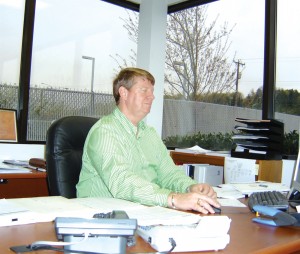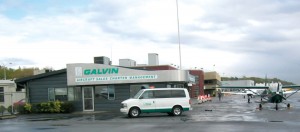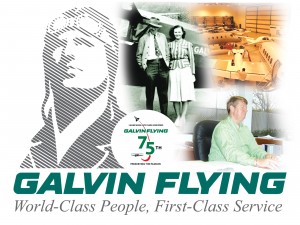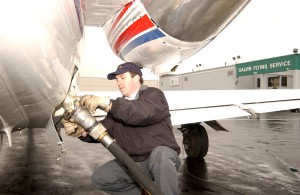By Deborah Hopen
Jim Galvin was a man with vision and the determination to make his dreams come true. This year marks the 75th anniversary of Galvin Flying Service, and it’s still easy to see Galvin’s legacy carried on today in the company’s philosophies and operational practices. Pilots, airplane owners and passengers all agree that Galvin offers superb customer service in every aspect of its business-—just as Galvin intended when he opened the business.
The early years
Born in 1904, within 12 months of the Wright brothers’ historic flight at Kitty Hawk, N.C., Galvin became interested in flying while serving in the U.S. Coast Guard. One day shortly after he’d been involved in an exchange of gunfire with a rum-smuggling operation on the East Coast, Galvin looked up and saw a plane flying above. He realized he was destined to be up in the beautiful sky looking down, rather than aboard his cutter looking up.
He finished his stint in the Coast Guard in the Los Angeles area and learned to fly. From that point forward, no flying job was too routine or too dangerous for him to tackle, but Galvin’s attention to superior maintenance and safe operations paid off. In over 12,000 hours of flying, he never crashed a plane or even had a serious scare.
He moved to Seattle when King County International Airport/Boeing Field was being completed and worked for several early Seattle aviators, saving money to purchase his first plane, a Swallow with a Hispano-Suiza engine. He barnstormed Washington and Oregon in his plane, making modifications to it that made it safer to fly and improved its operability. When he decided he needed a larger plane, he bought a Ryan B-1 Brougham.
On Oct. 31, 1930, Galvin leased space at Boeing Field and opened Galvin Flying Service. The company currently is the oldest general aviation business at the airport and is one of the oldest in the Pacific Northwest. Galvin flew search-and-rescue missions, transported reporters and photographers, and dropped supplies to forest fire fighters working in the mountains. He also operated the first air ambulance service in Washington, having the only plane large enough to carry a stretcher. On occasion, the plane even was used for wedding ceremonies conducted above the Seattle skyline.

Jim Galvin checks out the planes on the ramp at Boeing Field, including a Cessna 140 that was on site.
From the beginning, Galvin believed it was essential to offer pilot training and get new pilots into the pipeline. In addition to offering flight instruction for private pilots throughout its history, the company also prepared college students to become military pilots from 1940 to 1942, under a contract with the U.S. government. Over the years, many graduates of Galvin Flight School have gone on to careers in military and commercial aviation.
During the early 1940s, Galvin became concerned about the crowded conditions at Boeing Field. He purchased land nearby and began constructing an airport for flying clubs. Today that property is the site of Seattle-Tacoma International Airport. When civilian operations on the field were suspended during World War II, he moved his operation to Issaquah, Wash., and built an airport there.
Following the attack on Pearl Harbor, Galvin enlisted in the U.S. Navy. He served four years in the Air Ferry Command in Pensacola, Fla., and Brooklyn, N.Y.
The air taxi and flight school businesses moved back to Boeing Field when Galvin resumed leadership of the business. He also added aircraft refueling services at that time and became a sales distributor for Piper, Swift and Bellanca over the next decade.
Involving his family
Jim and Marian Galvin were married in 1937. They were business partners and constant companions for 54 years. Marian Galvin worked in virtually every area of the company over the years, except she never provided flight instruction.
Galvin had three brothers and a sister. Most of the family worked for the Galvin Supply Company, a tobacco and candy supply company. Galvin’s current president, Peter Anderson, is the son of Galvin’s sister. She worked at Boeing for many years, being one of the last employees released at the end of the supersonic transport program. Anderson joined the company when he was 15 years old, choosing to wash planes and sweep hangar floors for his Uncle Jim rather than stock shelves at Galvin Supply. That was in 1969, when the company had 10 employees, four airplanes and the flight school.
Even Anderson’s first day on the job was memorable. He biked from his home about four miles away from Boeing Field and arrived at work four hours late.
“That’s the first time I was fired by my uncle,” he recounted. “He explained to me that it didn’t matter how I had gotten there and that he didn’t care that I didn’t have a car. He pointed out that I had agreed to arrive at work at a certain time. Then he agreed to give me a second chance.”
By the mid-1970s, Jim Galvin was approaching 60, and a competitor offered to purchase the business. Anderson, who was in his early 20s, had progressed to refueling airplanes. Although he enjoyed working around airplanes, he never developed the love for flying that captured his uncle’s spirit. Similarly, his cousin Paul, Jim and Marian Galvin’s adopted son, worked as a flight instructor at the company but had no interest in taking over its leadership.
“So Jim Galvin turned to a cadre of about 20 advisors, including some customers, friends, his accountant, other business owners at the airport, and even that competitor, for some advice,” Anderson explains. “He asked of them the same question: ‘Should I give my nephew a chance?’ I found out later that all 20 of the advisers encouraged him to keep the business in the family.”
At that point, Galvin dedicated himself to a new role, teaching his young nephew how to run the business. He introduced Anderson to customers and took him to meetings. Along the way, Anderson met his future wife, Sarah, who was the company’s first internal bookkeeper and still works with him today.
In 1979, Galvin became chairman of the board and turned management of the business to Anderson. In 1989, he retired at age 85, after 59 years of involvement.
The Galvin way
Under Anderson’s direction, Galvin Flying Services expanded its services throughout the 1980s, despite the overall decline in general aviation during that period. When many leaseholds became available at Boeing Field, Anderson quietly acquired half a dozen of them, tying up quite a bit of the airport’s real estate at that time. Of course, that foresight laid the groundwork for the company’s current success, where the demand for space at Boeing Field far exceeds its availability.
“Jim Galvin was a fiscally-conservative person by nature. He never let the company go into debt. If he wanted another airplane or improvements to the facilities, funding came out of the profits,” Anderson said. “He also was a strong believer in customer service, even before that became a buzz word. His mission was to provide the best aviation service possible and to make it possible for others to become involved in aviation. These beliefs still are the cornerstone of the way we do business.”
Anderson said Jim Galvin clearly was in the business for the passion and love of flying.
“If he happened to earn enough money from the business to go beyond the basics, he’d add another airplane for the flight school or get a two-year-newer Bonanza for his charter fleet,” he said.
Galvin Flying Services has trained over 10,000 people to fly. It was one of the founding members in the National Air Transportation Association in 1940. Galvin’s staff has serviced presidents Reagan, Bush and Clinton when they stopped in Seattle. Even Donald Duck and his entourage stopped by Galvin’s terminal during their 50th anniversary tour in 1985.
“We think our company provides value to King County and the community at large,” Anderson comments. “We provide an opportunity for people who are interested in learning how to fly, maintaining aircraft, flying charter aircraft, or becoming flight instructors to get their start here, make progress, and go out into the world. Galvin staff and I have spent a lot of time educating members of the general community on what an airport does, how it functions, and how it affects their lives.”

Peter Anderson started washing planes and cleaning hangers at Galvin Flying when he was 15 and became president in 1980.
He said testimony to the effectiveness of these efforts is the fact that the airport still is open 24 hours a day, seven days a week, and the community works actively with the airport to resolve issues and communicate rather than just butting heads.
“We’re pleased and proud to say that we’ve had a very significant role in making that happen,” he said.
Galvin Flying Services also is involved with The Museum of Flight, the Experimental Aircraft Association’s Young Eagles program and Washington State Aeronautics’ aviation outreach programs. Anderson served as a director of NATA, and currently serves as the founding chair of the board of directors of Aviation High School. All of these efforts are aimed at encouraging young people to learn how to fly and become involved in the aviation field.
In the mid-1950s, Galvin received a Pioneer in Aviation commendation from the OX5 Aviation Pioneers. In 1980, he was named First Citizen of King County. Professional Pilot Magazine has recognized the company as Best Independent FBO seven times and one of the top three FBOs in the U.S. another seven times; Nancy Scheckler-Cecchi, Galvin’s customer service supervisor, received Top Ten in Customer Service commendations six times.
The school currently has 11 flight instructors that are designated as master instructors by the National Association of Flight Instructors, second only to Embry-Riddle in Daytona Beach. This sampling of the recognition and awards Galvin Flying Services and its staff have received demonstrates the company’s focus on achieving excellence in every aspect of its business.
Capable and loyal staff
Galvin’s capabilities match the best fixed base operators in the country. The company is very active in maintaining two-place trainers, Boeing business aircraft, and everything in between, but Anderson believes that the primary differentiator is the staff.
“We all have fuel trucks, we all have affiliations, and we all have authorizations, but the thing that makes us different is our people. I’m proud of every person on our team,” Anderson said. “Furthermore, customers tell me that we have a good staff of dedicated, hard-working people. We’re fortunate that we have over 20 staff members who have been here for 20 years or more. They’re the backbone of this company.
“We’ve also had many employees who started their aviation careers here, having a job that would help pay for their flying habit, and then moved on to the commuter airlines or corporate assignments. If it weren’t for my uncle Jim, I’d be very disappointed when employees went to work for other businesses after we had invested in their education and training; but he told me, and I still believe it to this day, that our job is to serve the aviation community. When former employees go to work somewhere else, they say, ‘I got my experience at Galvin Flying Service, receiving a solid foundation for my future endeavors. I’ll always have a strong heart for Galvin Flying Service.'”
Nick Frisch, manager of the flight school, tells about Anderson’s management style, saying, “My interactions with Peter during my first three years were very limited. He gave me some brief instructions, essentially telling me that Galvin had always had a flight school and wanted something of which it could be proud. He told me to show the world what a flight school ought to look like and to do so safely and legally. He supported me and made me feel comfortable. I felt free to push the limits and use my imagination as long as I took care of the customers and the employees and served the aviation community.”
Barbara Twardus, a former educational administrator for the Seattle School District, always had the dream of learning to fly. She started training after she retired and became a part-time customer service representative at Galvin’s flight school.
“Galvin offers a very supportive environment. Nick Frisch told me one time that Galvin’s job is to make people’s dreams come true, and that’s the way it really works here,” she declares. “What really struck me about Galvin is that all the people who work here are doing what they want to do; they’re not here because they have to be.”
After Twardus obtained her advanced ground instructor rating, Frisch assigned her to teach the companion flying course that was launched in 2004. The program prepares passengers to deal with emergencies, but it’s based on the premise that flying is fun, rather than scare tactics. It builds participants knowledge of terminology and provides some basic operational skills. People leave the class enthusiastic and wanting more training and flight time.
Memorable moments
The company’s charter fleet consisted of a Beechcraft Bonanza and a Piper Aztec for many years. Galvin was a quiet man with a twinkle in his eye, and employees knew that business was going well when he had little to say. If his planes were damaged in any way, a different side of his personality would become apparent.
The Piper Aztec was stored in a hangar that had only six inches of clearance at the wing tips; the plane also had to be pulled up a small hill to get it onto the ramp. The process took four people with two people watching the wingtips. One day Galvin was observing the right wingtip himself and told the employee with the tow bar that there was sufficient space to clear on his side.
“He kept saying, ‘Good, good, good, good,'” Anderson recalled. “With a rush of energy and adrenaline flowing, we left about five inches of the right wingtip in the hangar. Normally that would have been cause for laughter and some consternation. Under the circumstances, however, there was silence for about two minutes. Finally, Galvin said, ‘It’s okay to laugh,’ and everyone broke into boisterous laughter.”
In the early days, parking at the facility was extremely limited, so Galvin would monitor the lot carefully, tracking cars that had not been moved for long periods of time. One day he had a car towed that had been in the lot for over a month.
Later that same week the owner arrived from the San Juan Islands and learned that his car was gone. He angrily suggested that the employee who had arranged for his car to be towed should be fired. Galvin told the customer that he’d “see what he could do.”
The car belonged to Ernest Gann, author of the aviation book “Fate Is the Hunter,” who became one of Galvin’s closest friends. Galvin didn’t fire himself, but he did issue a memo to the staff the next day stating that the policy on having cars towed had been rescinded.
For many years, Jim Galvin’s myna bird George greeted guests as they passed his cage in the front lobby. George had an aviation vocabulary that exceeded 100 words, including “Welcome to Galvin Flying” and “Have you closed your flight plan?” When George passed away at the beginning of the jet age, several customers and friends bought Galvin new mynas, but all of them fixated on mimicking jet engine noises and couldn’t be trained successfully.
Al Crawford was associated with the company for 36 years. He started his career refueling airplanes, and worked his way up through the ranks to supervisor and later vice president. He headed the company’s operation, Galvin Aviation, at Seattle-Tacoma International Airport, which Crawford ultimately purchased in the mid-1980s and later sold to Butler Aviation in 1993.
“Jim Galvin was one of the finest people I’ve ever known, and so was Marian, his wife,” Crawford shared. “When I was 19 years old and dating my wife-to-be, Marian lent me her brand new Chrysler convertible to drive for the weekend when she was going to be out of town. They were very giving people. Galvin was a good boss who would meet you more than halfway.”
Don Filer, Galvin’s aviation insurance agent, was also a private pilot who used the company’s services and led Washington’s chapter of the Aircraft Owners and Pilots Association. He tells a similar story.

Galvin’s current charter terminal was the company’s original facility. It now includes a VIP lounge with full concierge services.
“Jim Galvin was a ‘fly boy.’ He loved to fly,” he said. “He had to balance his interest in flying and desire to be up in a plane at all times with the need for him to manage the business. It took a while for him to do that, but he was very successful at everything he did. Jim Galvin was a very fine gentleman, and if you loved him, you loved his company, because he operated the company on the same basis that he ran his life.”
The legacy
Anderson says Galvin has had 75 good years, so far, and he’s thankful for his part in the most recent 25.
“But Jim Galvin gets the entire credit for the first 50 years, from 1930 to 1980, and he continues to get credit today for the legacy he’s left all of us,” he said. “His teachings have taken us this far and are the foundation that will carry us on to our 100th anniversary and beyond.”
Additional information on Galvin Flying Services is available at [http://www.galvinflying.com.]















